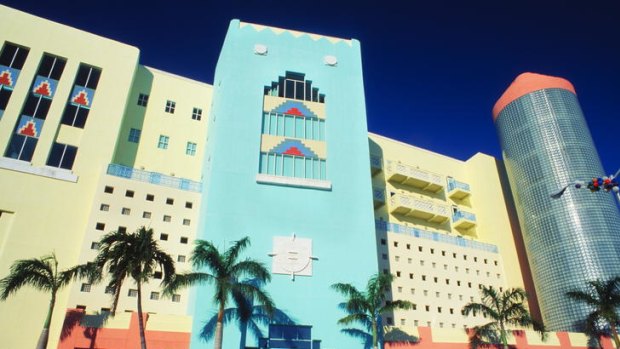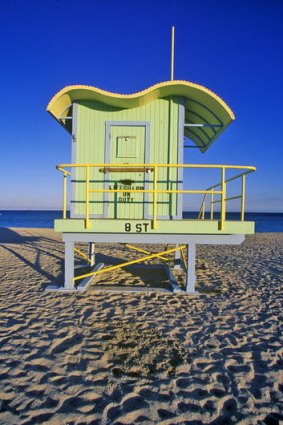This was published 12 years ago
The art of preservation
Thanks to the efforts of one woman, Miami Beach boasts the best collection of art deco buildings in the world, writes David Whitley.

A burst of colour in the art deco style.Credit: Getty Images
MOTHER Nature can often play a cruel hand in how a place looks and that applies to architecture as much as rubble-strewn volcanic slopes and the grassy flats of flood plains.
Art deco, in particular, is often a mark of disaster. Most towns where art deco is prevalent - from Innisfail in Queensland to Napier in New Zealand - have been levelled by cyclones or earthquakes, leaving ample room for rebuilding in the style of the time.
The world's largest concentration of art deco buildings, however, is in Miami Beach. Here, we have a hurricane to thank. When it hit in 1926, Miami Beach's fledgling tourism industry had to rebuild quickly or risk being wiped off the tourist map. Art deco had recently been born in Paris and was the hot, controversial new style in the US, so the modern look was in and was adapted to suit the Miami climate.

A lifeguard hut.Credit: Getty Images
The Essex Hotel is a faithfully refurbished example of what became known as the tropical art deco style. It has corner windows for cross breezes and the overhanging eyebrows create a shadow to stop the rooms getting too hot.
The exterior is painted in a white and pastel salmon - bright colours weren't used at first because paint technology wasn't up to it and hoteliers didn't want to spend money redecorating every year - but the better stories lie inside. Mosaic arrows built into the floor are a discreet way of pointing to what would have been a big attraction at the time of construction: the bar. Everyone wanted a drink during Prohibition but no one wanted to be seen asking where to get one.
The Everglades mural in the lobby also tells a tale of Miami Beach's history. When the hotel was restored in 1992, the original artist was tracked down to retouch his mural. He added one thing that wasn't there originally - a crocodile. It had been left out because the image of a swampy, snake- and alligator-infested backwater was one the marketers wanted to avoid.
There's an element of marketing behind many of the common features in the hotels. The porthole-style windows and the horizontal segments either side of a vertical segment are designed to make the hotels look like a ship. This "nautical" art deco look is deliberate. In the 1930s, cruising was for the super-rich only; hotels with a cruise-ship look could be sold as offering a taste of the high life.
The walking tours run by the Miami Design Preservation League are full of such useful snippets of information and if any organisation is going to know about art deco in Miami, the MDPL is it. After all, it saved most of the buildings. Miami Beach - particularly the South Beach area - was in a sorry state by the 1970s. The hotels were too small to turn a profit and a reputation for retirees and junkies turned the area into a rather grubby version of God's waiting room. Developers wanted to knock down the art deco buildings and replace them with characterless projects.
But in came Barbara Capitman, who came down from New York, saw the value of the buildings that were soon to be lost and started to whip up support for saving them. In August 1976, she formed the MDPL. In less than three years, the entire district was listed on the National Register of Historic Places. That is Olympian rabble-rousing.
The cool factor returned in 1984, when Miami Vice started filming. The producers wanted South Beach to look good on camera, so they pumped money into getting many of the properties - particularly those on Ocean Drive - spruced up. In came the brighter colours - they stand out better on TV - that now characterise many of the hotels.
The Breakwater hotel, on the corner of Ocean Drive and 10th Street, was the first to undergo small-screen surgery and it was also the scene for photographer Bruce Weber's famous Calvin Klein Obsession shoot in 1985. It wouldn't be the first time the cameras would descend. Throw in the celeb-pulling power of Gianni Versace's pool parties - the designer with the Ocean Drive mansion was the wardrobe consultant on Miami Vice - and South Beach was suddenly one of the hippest joints on the planet.
But popularity wasn't going to solve all the problems. Running 40-room hotels was just not going to be economical - and now buildings weren't allowed to be torn down. Perhaps the most fascinating aspect of the tour is how the hotels have dealt with this. Route one was to incorporate the neighbouring hotel - the Breakwater is a good example of this; many of the rooms are in the building that still has the Edison sign on it. Others have built modern extensions in the gaps.
Straight-out replica art deco buildings have been banned to protect the 800 or so originals on the National Register. The wing added in 2004 to the Hotel Victor, for example, complements and pays tribute without being a slavish copy. The eyebrows above the windows are cornered rather than curving and the nautical hitch to the past is achieved by making the balconies look as if they belong on a cruise ship. It soon becomes apparent, though, that the glory of South Beach isn't in any one particular art deco work. It's in the non-uniform ubiquity of them. Each has its own character - the Tides has an Empire State Building-like grandeur, the Congress does gleaming white simplicity, the pokier ones on Collins Avenue a block back from Ocean Drive make up for lack of size with a riot of colour. The variety within the theme means that the district looks instantly distinctive.
You can't even escape from it on the beach - the lifeguard huts have also been specially designed in a perky art deco style. And, in a way, they're a more fitting tribute to the campaigners that saved art deco Miami Beach than any plaques or road-namings could ever be.
The writer was a guest of the Greater Miami Convention and Visitors Bureau.
Trip notes
Getting there
Delta, United and Qantas fly from Sydney to Miami via Los Angeles.
Staying there
The newly refurbished Breakwater (940 Ocean Drive, + 1 305 532 2362, breakwater southbeach.com) gets the mix of style and luxury spot on — right down to the private towelled beach sunbeds. Rooms start at $US271.20, including tax and resort fee.
See + do
The Miami Design Preservation League's walking tour departs from the Art Deco Welcome Centre at 1001 Ocean Drive. Ninety-minute tours cost $US20 ($19) and run daily at 10.30am, except on Thursdays, when they're at 6.30pm. +1 305 672 2014, mdpl.org.
More information
miamiandbeaches.com.
Sign up for the Traveller Deals newsletter
Get exclusive travel deals delivered straight to your inbox. Sign up now.